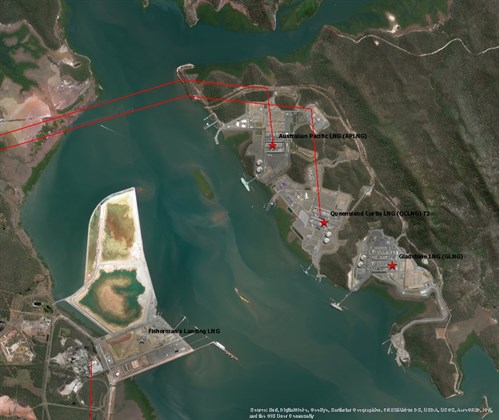Australia's east coast LNG plants unlikely to ever hit full capacity
MELBOURNE, (Reuters) - Australia’s three east coast liquefied natural gas (LNG) plants are unlikely to ever run at their combined full capacity of 25.3 million tons a year as there is not enough gas to feed them and meet local demand, a study released said.

The three plants - Queensland Curtis LNG, Australia Pacific LNG and Gladstone LNG - were the world’s first LNG exporters to use coal seam gas rather than gas from conventional fields.
But the wells they source their gas from in Australia’s Surat and Bowen basins in Queensland state have turned out to be less productive than expected.
As a result, the three plants - each with two processing units - have been running below capacity, operating at average 82 percent in 2018.
“Unfortunately, there are serious headwinds coming and the outlook is less rosy as the industry over-reached by building three projects of six trains,” EnergyQuest CEO Graeme Bethune said in a statement.
QCLNG, run by Royal Dutch Shell averaged 87 percent capacity, and GLNG, run by Santos, only 65 percent, EnergyQuest, an industry consultancy, said.
In a detailed study of government and company drilling and production data and reserves booked at coal seam gas (CSG) prospects and licenses, it found that only 56 percent of booked proven and probable reserves had shown any commercial productivity.
“The emerging and critical shortages are resulting from the fact the CSG LNG projects were sanctioned on ambitious estimates of proved and probable (2P) reserves, not proven reserves (1P) that underpin conventional LNG projects,” Bethune said.
He predicted that by 2025 at least two trains would have to be shut to keep four trains running at full capacity, which would reduce medium-term exports to around 17 million tons a year, down from about 21 million tons in 2018.
About 70 percent of exports go to China, 16 percent to South Korea and 9 percent to Japan.
Exacerbating the problem, the producers have come under pressure to step up gas sales into the domestic market, with supply in Australia’s southeast falling as ageing offshore fields dry up and as states restrict drilling onshore.
“With dwindling production from southern gas fields, the political pressure on the LNG producers to divert gas to the domestic market is likely to intensify,” Bethune said.
($1 = 1.3961 Australian dollars)
Reporting by Sonali Paul; editing by Richard Pullin

- ExxonMobil halts 1-Bft3d blue hydrogen project in Texas
- Aramco and Yokogawa commission multiple autonomous control AI agents at Fadhili gas plant
- Ukraine will resume gas imports via Transbalkan route in November
- Mitsubishi to inject $260 MM into Brunei LNG project
- Freeport LNG (U.S.) on track to take in more natgas on Thursday after unit outage



Comments